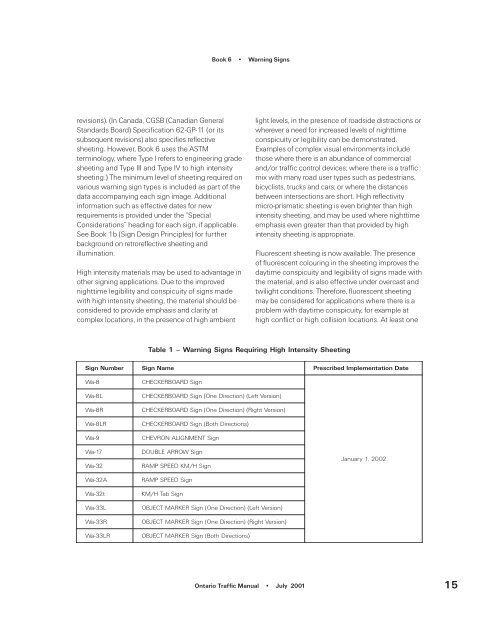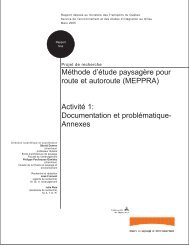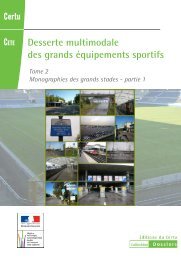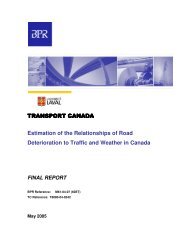Create successful ePaper yourself
Turn your PDF publications into a flip-book with our unique Google optimized e-Paper software.
evisions). (In Canada, CGSB (Canadian General<br />
Standards Board) Specification 62-GP-11 (or its<br />
subsequent revisions) also specifies reflective<br />
sheeting. However, Book 6 uses the ASTM<br />
terminology, where Type I refers to engineering grade<br />
sheeting and Type III and Type IV to high intensity<br />
sheeting.) The minimum level of sheeting required on<br />
various warning sign types is included as part of the<br />
data accompanying each sign image. Additional<br />
information such as effective dates for new<br />
requirements is provided under the “Special<br />
Considerations” heading for each sign, if applicable.<br />
See Book 1b (Sign Design Principles) for further<br />
background on retroreflective sheeting and<br />
illumination.<br />
High intensity materials may be used to advantage in<br />
other signing applications. Due to the improved<br />
nighttime legibility and conspicuity of signs made<br />
with high intensity sheeting, the material should be<br />
considered to provide emphasis and clarity at<br />
complex locations, in the presence of high ambient<br />
Book 6 Warning Signs<br />
light levels, in the presence of roadside distractions or<br />
wherever a need for increased levels of nighttime<br />
conspicuity or legibility can be demonstrated.<br />
Examples of complex visual environments include<br />
those where there is an abundance of commercial<br />
and/or <strong>traffic</strong> control devices; where there is a <strong>traffic</strong><br />
mix with many road user types such as pedestrians,<br />
bicyclists, trucks and cars; or where the distances<br />
between intersections are short. High reflectivity<br />
micro-prismatic sheeting is even brighter than high<br />
intensity sheeting, and may be used where nighttime<br />
emphasis even greater than that provided by high<br />
intensity sheeting is appropriate.<br />
Fluorescent sheeting is now available. The presence<br />
of fluorescent colouring in the sheeting improves the<br />
daytime conspicuity and legibility of signs made with<br />
the material, and is also effective under overcast and<br />
twilight conditions. Therefore, fluorescent sheeting<br />
may be considered for applications where there is a<br />
problem with daytime conspicuity, for example at<br />
high conflict or high collision locations. At least one<br />
SignNumberSignName Prescribed<br />
Implementation<br />
Date<br />
Wa-8CHECKERBOARDSign Wa-8LC HECKERBOARD<br />
Sign<br />
( One<br />
Direction)<br />
( Left<br />
Version)<br />
Wa-8RC HECKERBOARD<br />
Sign<br />
( One<br />
Direction)<br />
( Right<br />
Version)<br />
Wa-8LRC HECKERBOARD<br />
Sign<br />
( Both<br />
Directions)<br />
Wa-9CHEVRONALIGNMENTSign Wa-17DOUBLEARROWSign Wa-32RAMPSPEEDKM/ H Sign<br />
Wa-32ARAMPSPEEDSign Wa-32tKM/ H Tab<br />
Sign<br />
Table 1 – Warning Signs Requiring High Intensity Sheeting<br />
Wa-33LO BJECT<br />
MARKER<br />
Sign<br />
( One<br />
Direction)<br />
( Left<br />
Version)<br />
Wa-33RO BJECT<br />
MARKER<br />
Sign<br />
( One<br />
Direction)<br />
( Right<br />
Version)<br />
W a-33LR<br />
OBJECT<br />
MARKER<br />
Sign<br />
( Both<br />
Directions)<br />
January<br />
1,<br />
2002<br />
<strong>Ontario</strong> Traffic Manual July 2001 15





